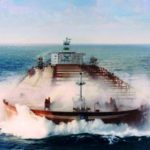
A new report from UCL’s Energy Institute Shipping and Oceans Research Group assesses the financial risks to the shipping industry from stranded assets due to stricter GHG regulations, to be adopted at this year’s IMO, combined with the ongoing global transition to low energy carbon. system. The report finds that the shipping sector faces major supply-side risks related to the obsolescence of carbon-intensive vessels, and demand-side risks related to declining demand for fossil fuels. All investors need to actively address these risks through strategic investment choices, energy efficiency measures, and proactive planning for IMO medium-term measures and broader climate change policies.
The report found that more than 40% of ships worldwide carry fossil fuels, and almost all ships use fossil fuels. To align with shipping’s estimated share of the carbon budget of 9.6 gigatons, ships representing more than a third of the value of the existing and on-order fleet will need to quickly switch to zero-emission technology or face premature demise. The shift away from fossil fuels to the broader economy creates a further risk of oversupply on ships carrying fossil fuels. In particular, liquefied petroleum gas tankers are likely to face the highest risk, with 26–32% of the fleet at risk by 2030.
Marie Fricaudet, PhD Student at UCL Energy Institute, said: “If existing ships could be adapted to zero/near-zero competitive technologies, a large proportion of the fleet at risk of stranding could be saved, and this is a strong incentive for investors. to invest in ships that can be retrofitted. However, even such retrofits will come at a cost, so we expect asset devaluation as medium-term measures become more material.”
Increasing evidence suggests that shipowners and financiers did not anticipate a rapid transition, see for example the authors examining financier confidence. In the short term, transition risks, such as those related to policy, litigation, and technology, do not appear to be entirely credible to them. As a result, these risks are unlikely to be adequately factored into their investment decisions, thereby exacerbating transition risks, as shown in a separate study by the authors which revealed that the carbon intensity of a ship does not directly impact the borrowing costs for that ship. .
Dr Nishatabbas Rehmatulla, Principal Researcher at the UCL Energy Institute, said: “Our research to date consistently shows that most shipping stakeholders, particularly investors including shipowners and financiers, do not anticipate an ambitious transition. This research shows that an investment strategy based on ‘watch and wait’ is a risky strategy, it can result in rapid and unexpected declines in value and losses caused by forces within and outside the sector”
Shipowners and financiers can manage or account for demand-side risks by avoiding investments in segments with uncertain future transportation demand, investing in options for reuse in other cargoes, and by factoring these risks into expected returns. Retrofitting and reusing vessels will reduce the number of stranded assets but can still be an expensive alternative. Uncertainty in the future technology mix makes planning difficult but proactive management through optionality, for example through dual-fuel vessels, of the supply side risks of abandoned assets remains necessary.
Dr Tristan Smith, Professor of Energy and Transport at the UCL Energy Institute said: “The IMO sets its course for 2023, and therefore clarifies the supply side risks discussed here. The strategy’s ambitions are close to the 1.5°C scenario used in this analysis. With evidence from earlier this month that further momentum is building behind universal GHG pricing and an IMO package of medium-term measures that could provide strong incentives for the transition, there will be a further crystallization of these risks this year. But perhaps the important point of this analysis is that once there is no doubt that fossil fuel technology, including LNG as fuel and cargo, is experiencing rapid contraction, it will be too late for many to take corrective action.”
Investing in energy efficiency provides a degree of resilience in all scenarios by enabling fossil fuel-powered ships to comply with climate regulations and lower emissions over long periods of time, giving time for the fuel mix to stabilize and reducing tank and engine size requirements. while maintaining the same level of transportation capacity, thereby increasing operational flexibility and efficiency.
Link to full report: https://www.shippingandoceans.com/post/Existing-ships-and-those-on-order-would-produce-twice-the-emissions
Source: UCL Energy Institute Shipping




